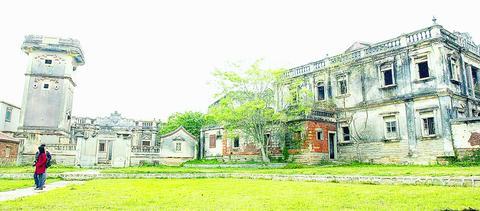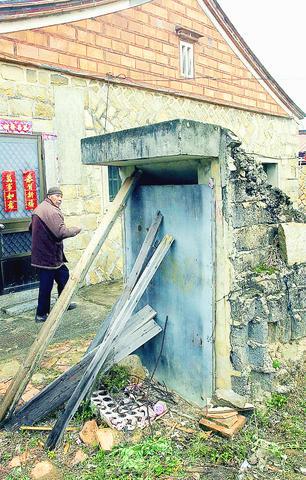Kinmen Island strikes most people as an armored military fortress situated in the frontline of the Taiwan Strait against China's military threat. Its military legacy is well known, but what lies underneath is a land rich in cultural diversity and architectural beauty.
Lying along the southeast coast of China's Fukien Province, Kinmen is of strategic importance for Taiwan's defense against China.
It first opened to tourism in 1994, which led to a rediscovery of Kinmen's unique mixture of Minnan culture and western influence. Kinmen is a major hometown of many overseas Chinese.

PHOTO: SEAN CHAO, TAIPEI TIMES
Singapore has the largest overseas Kinmen population. Today, the overseas Kinmen population outnumbers the locals.
Growing awareness of the island's vast Minnan heritage, western architecture and defunct military sites has prompted Kinmen locals and the central government to preserve and renovate the island's precious historical and cultural assets.
The Council for Cultural Affairs (CCA) has funds for a series of projects for these historical sites. The projects include cultural education programs and a Kinmen cultural park project. Subsidies available to Kinmen for cultural development totaled NT$428 million last year.

PHOTO: SEAN CHAO, TAIPEI TIMES
Under these initiatives, the renovation of western style buildings or Yang-lo (
Professor Chiang Bo-wei (
"They introduced western values, lifestyles and `novel' concepts of sanitation and hygiene to their hometowns. With funds channeled back to Kinmen from abroad, their families were usually better off than other locals," Chiang said.

PHOTO: SEAN CHAO, TAIPEI TIMES
The western style houses are hybrids of Chinese and western cultures, Chiang said.
Chiang who devoted his academic research to Kinmen's native Minnan Chinese and western style architecture, moved from Taiwan to Kinmen a decade ago.
"They [the structures] were built by successful Kinmen overseas businessmen upon their return from Southeast Asia," Chiang said.
The architectural style peaked in Kinmen between the 1920s and 1930s when there was a surge of funds coming into Kinmen.
The 131 western style buildings are located in some 50 villages and towns in the Greater Kinmen Island area and the Lieh-yu islet on the western side.
Shui-tou (
The western style architecture resembles colonial style buildings in Southeast Asia in both the Malay Peninsula and Singapore, Chiang said.
The "five-foot way" verandas, adopted from the British urban planning in Singapore during its colonization period in 1882, is a vivid representation of foreign cultural influence.
The "five-foot-way" refers to a clear passage measuring five feet wide in front of the store along with an attached overhanging roof to keep out rain and bright sunshine.
In Kinmen's Mofan Street (
The western style can be seen in the one-story "barbarian houses," the two-story "five-foot-way" buildings and the houses with overhangs.
"Barbarian house" is a derogatory term referring to a traditional Chinese house with a western pediment, while the western houses with verandas in Kinmen can be characterized as "five-foot-way" buildings -- structures which have become a distinctive architectural feature in Kinmen.
Most of the western style houses were built with brick and stone. Many of the structures are decorated with colorful Victorian tiles which give many of Kinmens's structures a distinctive appearance.
One can imagine the beauty of these buildings during the island's era of wealth. However, as the owners of these western houses have settled overseas, many of the buildings have been abandoned.
"The structures need good repairs and restoration," said CCA Chairwoman Tchen Yu-chiou (
"The revitalization of cultural and historical heritage is part of the objective in the council's development scheme for the nation's creative industry," Tchen said.
By recognizing the cultural value of Kinmen, Tchen said the abundant cultural features are a potential tourism attraction for Kinmen in addition to its military attractions.
"But first of all, we need to restore the essence of these cultural and historical assets," Tchen said.
However, for Kinmen, it seems that the island's economic reliance on the "small three links," which also makes Kinmen an important transit stop across the Strait, matters far more to the people in Kinmen than cultural development.
Local cultural workers complain that "the Kinmen government put the priority of the island's development on the opening of the `small three links.'"
"Many of our cultural works have been left in a state of disrepair," a Kinmen's cultural worker said on condition of anonymity.
In addition to the western style houses built by overseas Kinmen people, traditional Minnan Chinese houses -- spread around the villages of Kinmen -- also reflect a sense of antiquity about Kinmen.
Unlike Taiwan, where most traditional houses have been torn down and replaced by modern concrete structures, the Minnan architectural features from the Fukien Province in Kinmen have been well preserved.
Some of the Minnan buildings have roofs that have sharp, pointed shapes, while others display more circular curves. Yet all of the roofs all are designed according to Chinese geomancy on the concept of the five elements: gold, wood, water, fire and earth.
In Kinmen, villages are usually formed by people who have the same ancestral relations. Almost every village has an ancestral shrine bearing the symbol of the village, which is the family name of most of the residents.
Some of these ancestral shrines were built 450 years ago.
Due to a big exodus of Kinmen immigrants in other parts of Asia, and mainly in Taiwan, the old houses are kept up or lived in by the elderly.
Some people have built new antique-style houses to ensure that the buildings blend in with the older structures.
Many old ladies are not shy about inviting tourists in for a cup of tea and snacks.
Many of their descendents moved to live and work in Taiwan, and only during the Chinese New Year or major traditional festivals, do the children return home.
"This big house accommodates all of my children and grandchildren," an old lady said. "But their lives are better in Taiwan," she said.

A magnitude 4.9 earthquake struck off Tainan at 11:47am today, the Central Weather Administration (CWA) said. The hypocenter was 32.3km northeast of Tainan City Hall at a depth of 7.3km, CWA data showed. The intensity of the quake, which gauges the actual effect of a seismic event, measured 4 in Tainan and Chiayi County on Taiwan's seven-tier intensity scale, the data showed. The quake had an intensity of 3 in Chiayi City and County, and Yunlin County, while it was measured as 2 in Kaohsiung, Nantou County, Changhua County, Taitung County and offshore Penghu County, the data showed. There were no immediate reports of

The Chinese Nationalist Party (KMT) is maintaining close ties with Beijing, the Democratic Progressive Party (DPP) said yesterday, hours after a new round of Chinese military drills in the Taiwan Strait began. Political parties in a democracy have a responsibility to be loyal to the nation and defend its sovereignty, DPP spokesman Justin Wu (吳崢) told a news conference in Taipei. His comments came hours after Beijing announced via Chinese state media that the Chinese People’s Liberation Army’s Eastern Theater Command was holding large-scale drills simulating a multi-pronged attack on Taiwan. Contrary to the KMT’s claims that it is staunchly anti-communist, KMT Deputy

Weather conditions across Taiwan are expected to remain stable today, but cloudy to rainy skies are expected from tomorrow onward due to increasing moisture in the atmosphere, according to the Central Weather Administration (CWA). Daytime highs today are expected to hit 25-27°C in western Taiwan and 22-24°C in the eastern counties of Yilan, Hualien, and Taitung, data on the CWA website indicated. After sunset, temperatures could drop to 16-17°C in most parts of Taiwan. For tomorrow, precipitation is likely in northern Taiwan as a cloud system moves in from China. Daytime temperatures are expected to hover around 25°C, the CWA said. Starting Monday, areas

RESPONSE: The government would investigate incidents of Taiwanese entertainers in China promoting CCP propaganda online in contravention of the law, the source said Taiwanese entertainers living in China who are found to have contravened cross-strait regulations or collaborated with the Chinese Communist Party (CCP) could be subject to fines, a source said on Sunday. Several Taiwanese entertainers have posted on the social media platform Sina Weibo saying that Taiwan “must be returned” to China, and sharing news articles from Chinese state media. In response, the Mainland Affairs Council (MAC) has asked the Ministry of Culture to investigate whether the entertainers had contravened any laws, and asked for them to be questioned upon their return to Taiwan, an official familiar with the matter said. To curb repeated